南方医科大学学报 ›› 2025, Vol. 45 ›› Issue (5): 986-994.doi: 10.12122/j.issn.1673-4254.2025.05.11
梁晓涛1( ), 熊一凡1, 刘雪琪5, 梁小珊4, 朱晓煜1, 谢炜1,2,3,4(
), 熊一凡1, 刘雪琪5, 梁小珊4, 朱晓煜1, 谢炜1,2,3,4( )
)
收稿日期:2025-01-23
出版日期:2025-05-20
发布日期:2025-05-23
通讯作者:
谢炜
E-mail:1092296938@qq.com;xieweizn@126.com
作者简介:梁晓涛,医师,在读博士研究生,E-mail: 1092296938@qq.com
基金资助:
Xiaotao LIANG1( ), Yifan XIONG1, Xueqi LIU5, Xiaoshan LIANG4, Xiaoyu ZHU1, Wei XIE1,2,3,4(
), Yifan XIONG1, Xueqi LIU5, Xiaoshan LIANG4, Xiaoyu ZHU1, Wei XIE1,2,3,4( )
)
Received:2025-01-23
Online:2025-05-20
Published:2025-05-23
Contact:
Wei XIE
E-mail:1092296938@qq.com;xieweizn@126.com
About author:First author contact:LIANG Xiaotao1, XIONG Yifan1, LIU Xueqi5, LIANG Xiaoshan4, ZHU Xiaoyu1, XIE Wei1, 2, 3, 4
摘要:
目的 探讨活血疏风颗粒对慢性偏头痛(CM)小鼠中枢敏化的干预作用及机制。 方法 通过文献检索获取活血疏风颗粒的主要化学成分,使用多重数据库分析预测药理机制。动物实验验证:选用雄性SPF C57BL/6J小鼠,使用腹腔注射硝酸甘油给药(10 mg/kg),隔日注射,连续注射5次,制备偏头痛小鼠模型。以活血疏风颗粒灌胃或托吡酯腹腔注射进行干预,根据干预方式的不同将小鼠分为对照组、慢性偏头痛模型组、托吡酯阳性对照组、活血疏风颗粒低剂量组、活血疏风颗粒高剂量组(HXSFG-H),12只/组。利用Von Frey和热板仪装置评估小鼠中枢敏化程度,RT-qPCR检测炎症相关因子,Western blotting检测TLR4/NF-κB通路表达水平,免疫荧光实验检测c-Fos、CGRP的活化水平。 结果 网络药理学结果显示,活血疏风颗粒改善CM的主要活性成分为芒柄花素、芍药苷、槲皮素、丹参酮等,GO功能富集分析得到共得到492条信号通路,其中生物过程366条,细胞组分46条,分子功能80条;KEGG富集分析显示,活血疏风颗粒改善慢性偏头痛的通路主要涉及Toll样受体和NF-κB信号通路。动物实验成功构建CM小鼠模型,托吡酯阳性对照组和活血疏风颗粒治疗组小鼠中枢敏化减轻,表现为机械痛阈值和热痛阈值下降程度的减小。活血疏风颗粒可降低c-Fos和CGRP的表达(P<0.01),改善炎症相关指标(P<0.01);下调TLR4、p-NF-κB、IL-1β、TNF-α蛋白表达(P<0.01)。 结论 活血疏风颗粒能有效调节炎症通路,抑制TLR4/NF-κB信号转导,减轻中枢敏化。
梁晓涛, 熊一凡, 刘雪琪, 梁小珊, 朱晓煜, 谢炜. 活血疏风颗粒通过抑制TLR4/NF-κB通路改善慢性偏头痛小鼠的中枢敏化[J]. 南方医科大学学报, 2025, 45(5): 986-994.
Xiaotao LIANG, Yifan XIONG, Xueqi LIU, Xiaoshan LIANG, Xiaoyu ZHU, Wei XIE. Huoxue Shufeng Granule alleviates central sensitization in chronic migraine mice via TLR4/NF-κB inflammatory pathway[J]. Journal of Southern Medical University, 2025, 45(5): 986-994.
| Primer name | Sequence |
|---|---|
| IFN-γ Forward | AGCAACAACATAAGCGTCATTGA |
| IFN-γ Reverse | TGACCTCAAACTTGGCAATACTC |
| TNF-α Forward | GCCTCCCTCTCATCAGTTCTATG |
| TNF-α Reverse | ACCTGGGAGTAGACAAGGTACAA |
| IL-1β Forward | GCAACTGTTCCTGAACTCAACT |
| IL-1β Reverse | ATCTTTTGGGGTCCGTCAACT |
| IL-6 Forward | ACAACCACGGCCTTCCCTACTT |
| IL-6 Reverse | CACGATTTCCCAGAGAACATGTG |
| GAPDH Forward | CAACTACATGGTCTACATGTTC |
| GAPDH Reverse | CTCGCTCCTGGAAGATG |
表1 本研究涉及的引物序列
Tab.1 Primer sequences used in this study
| Primer name | Sequence |
|---|---|
| IFN-γ Forward | AGCAACAACATAAGCGTCATTGA |
| IFN-γ Reverse | TGACCTCAAACTTGGCAATACTC |
| TNF-α Forward | GCCTCCCTCTCATCAGTTCTATG |
| TNF-α Reverse | ACCTGGGAGTAGACAAGGTACAA |
| IL-1β Forward | GCAACTGTTCCTGAACTCAACT |
| IL-1β Reverse | ATCTTTTGGGGTCCGTCAACT |
| IL-6 Forward | ACAACCACGGCCTTCCCTACTT |
| IL-6 Reverse | CACGATTTCCCAGAGAACATGTG |
| GAPDH Forward | CAACTACATGGTCTACATGTTC |
| GAPDH Reverse | CTCGCTCCTGGAAGATG |
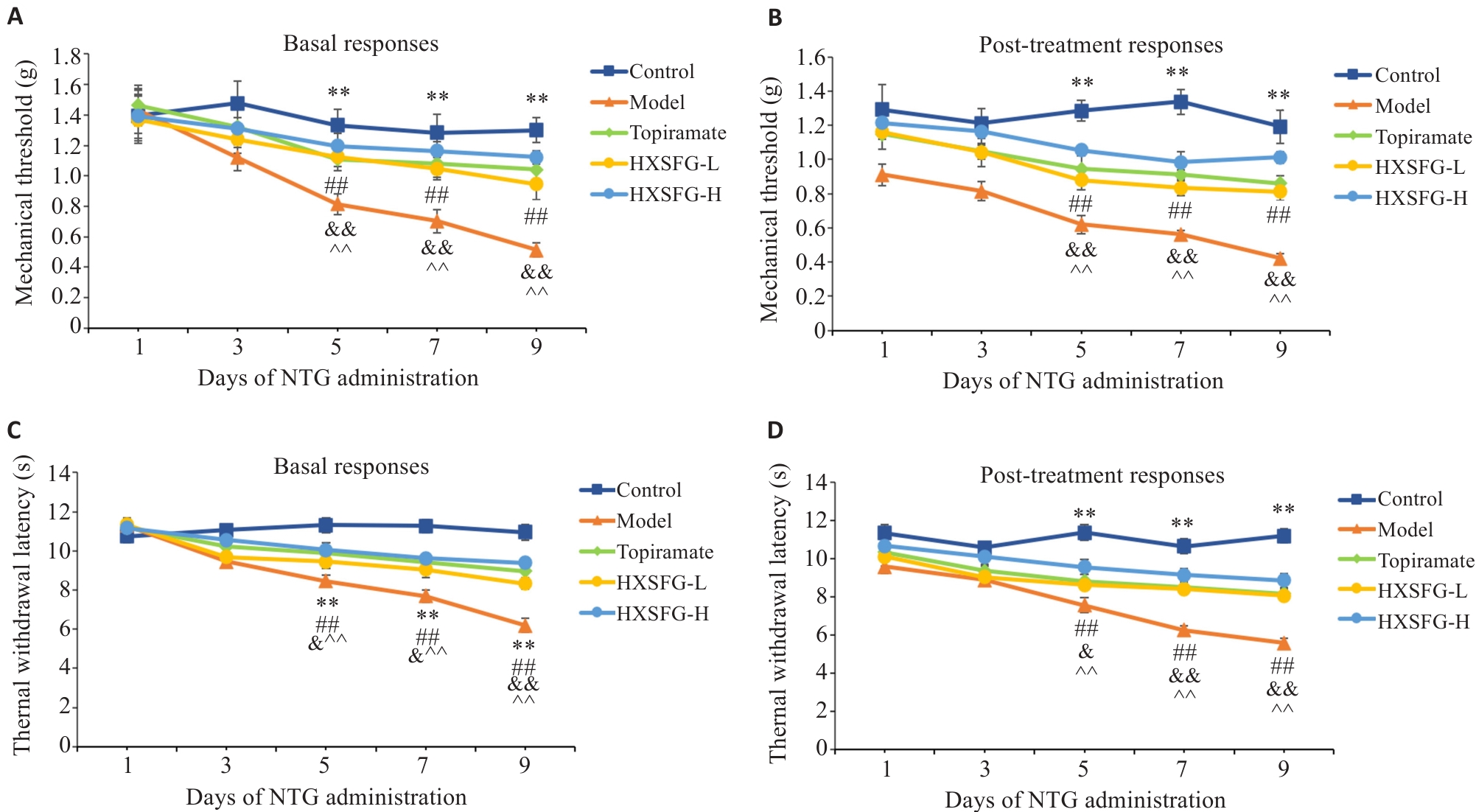
图2 活血疏风颗粒显著减轻 NTG 诱导的CM小鼠后爪基础及急性机械痛觉和热痛觉过敏
Fig.2 HXSFG alleviates baseline and acute mechanical and thermal hyperalgesia in mice with NTG-induced CM. A: Changes in baseline mechanical pain thresholds of the hind paws of the mice. B: Changes in acute mechanical pain thresholds of the hind paws of the mice. C: Changes in baseline thermal pain thresholds of the hind paws. D: Changes in acute thermal pain thresholds of the hind paws. Data are presented as Mean±SE (n=12). Statistical analysis was performed using two-way ANOVA followed by Tukey's post hoc test. **P<0.01 Model group vs Control group; #P<0.05, ##P<0.01 Topiramate group vs Model group; &P<0.05, &&P<0.01 HXSFG-L group vs Model group; ^^P<0.01 HXSFG-H group vs Model group.
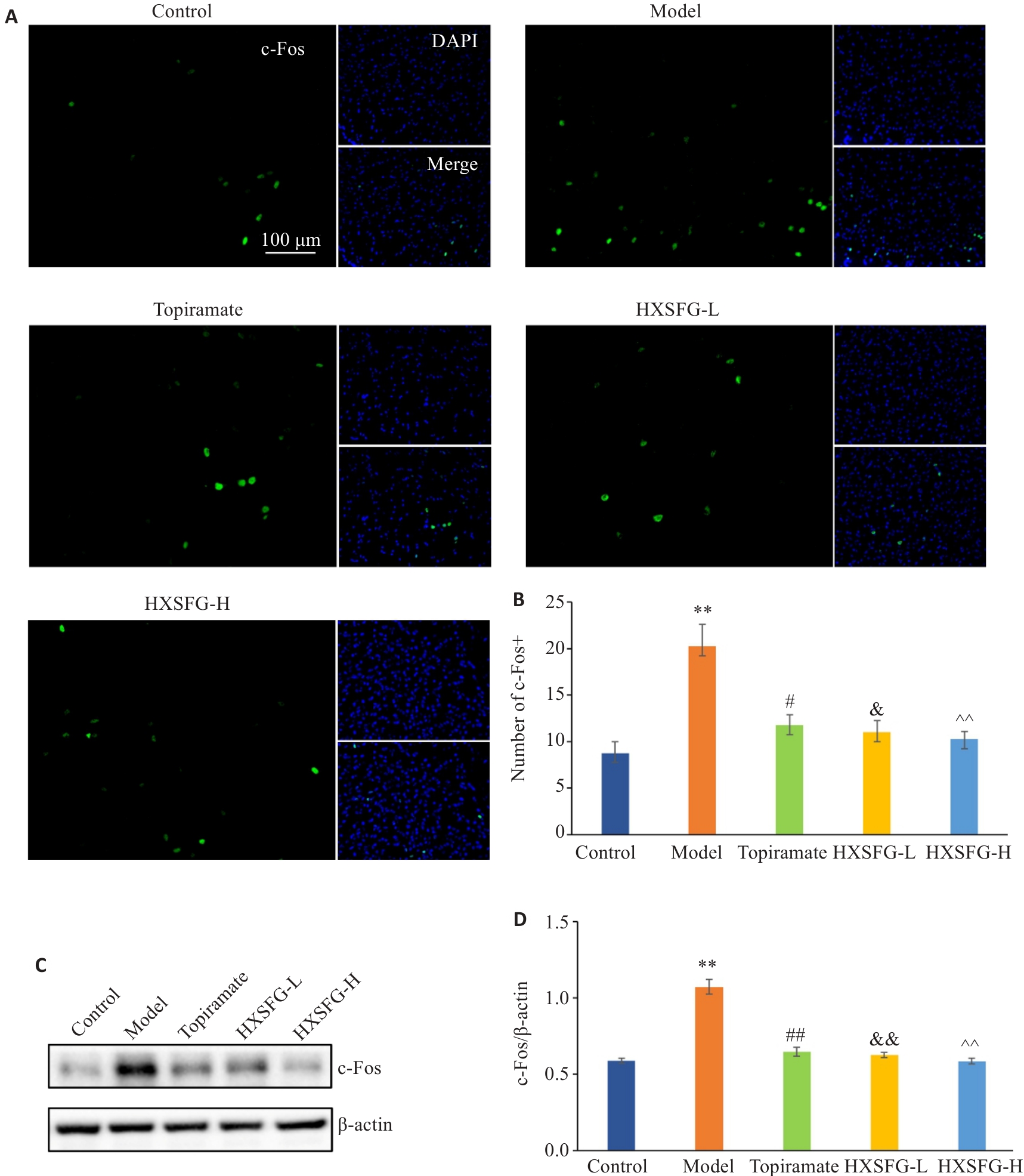
图3 活血疏风颗粒对NTG 诱导的CM小鼠TNC部位c-Fos表达水平的影响
Fig.3 Effects of HXSFG on c-Fos expression levels in the TNC region of mice with NTG-induced CM. A: Immunofluorescence images of c-Fos expression (Scale bar: 100 μm). B: Quantitative analysis of c-Fos immunoreactivity (Each group included 4 mice, and 3 slices were analyzed for each mouse). C: Protein immunoblot images of c-Fos expression. D: Quantitative analysis of c-Fos protein immunoblotting (n=4). Data are presented as Mean±SE. Statistical analysis was performed using two-way ANOVA followed by Tukey's post hoc test. **P<0.01 vs Control group; #P<0.05, ##P<0.01 vs Model group; &P<0.05, &&P<0.01 vs Model group; ^^P<0.01 vs Model group.
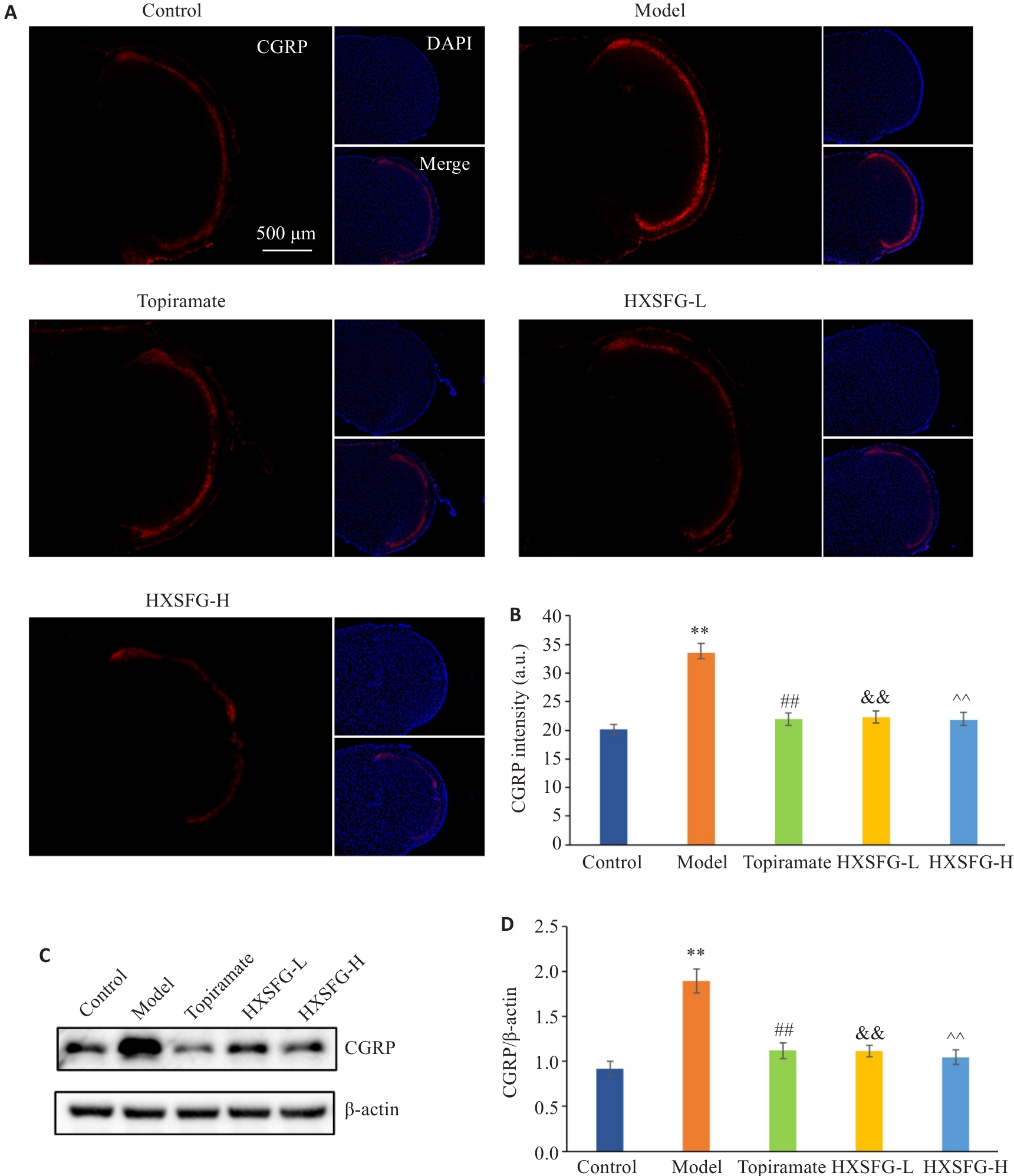
图4 活血疏风颗粒对NTG 诱导的CM小鼠TNC部位CGRP表达水平的影响
Fig.4 Effects of HXSFG on CGRP expression levels in the TNC region of mice with NTG-induced CM. A: Immunofluorescence images of CGRP expression (×40, scale bar: 500 μm). B: Quantitative analysis of CGRP immunoreactivity (Each group included 4 mice, and 3 slices were analyzed for each mouse). C: Protein immunoblot images of CGRP expression. D: Quantitative analysis of CGRP protein immunoblotting (n=4). Data are presented as Mean±SE. Statistical analysis was performed using two-way ANOVA followed by Tukey's post hoc test. **P<0.01 vs Control group; ##P<0.01 vs Model group; &&P<0.01 vs Model group; ^^P<0.01 vs Model group.
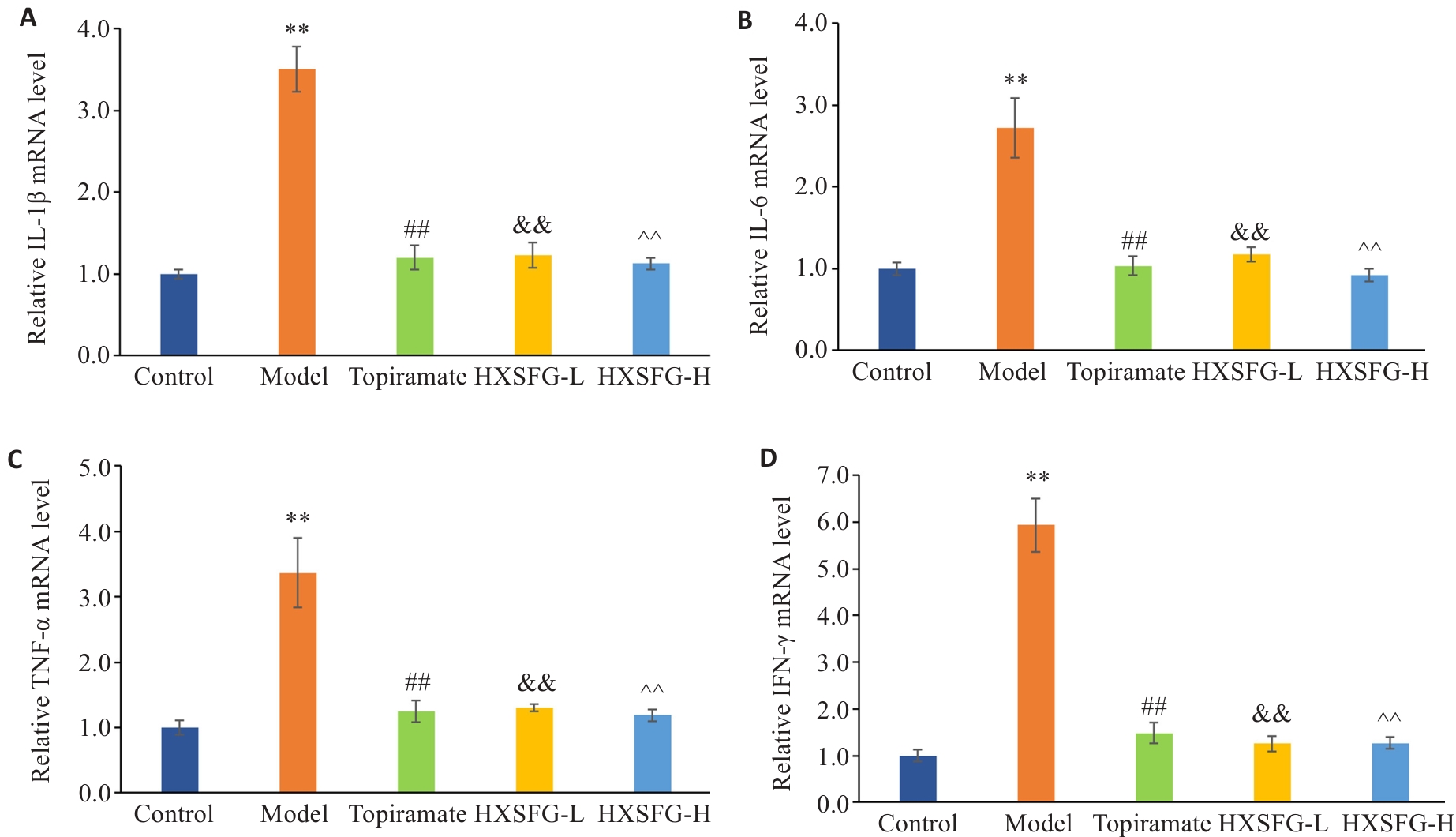
图5 活血疏风颗粒对NTG 诱导的CM小鼠TNC部位炎症因子表达水平的影响
Fig.5 Effects of HXSFG on mRNA levels of inflammatory factors in the TNC region of mice with NTG-induced CM. A: Relative mRNA level of IL-1β. B: Relative mRNA level of IL-6. C: Relative mRNA level of TNF‑α. D: Relative mRNA level of IFN-γ. **P<0.01 vs Control group; ##P<0.01 vs Model group; &&P<0.01 vs Model group; ^^P<0.01 vs Model group.
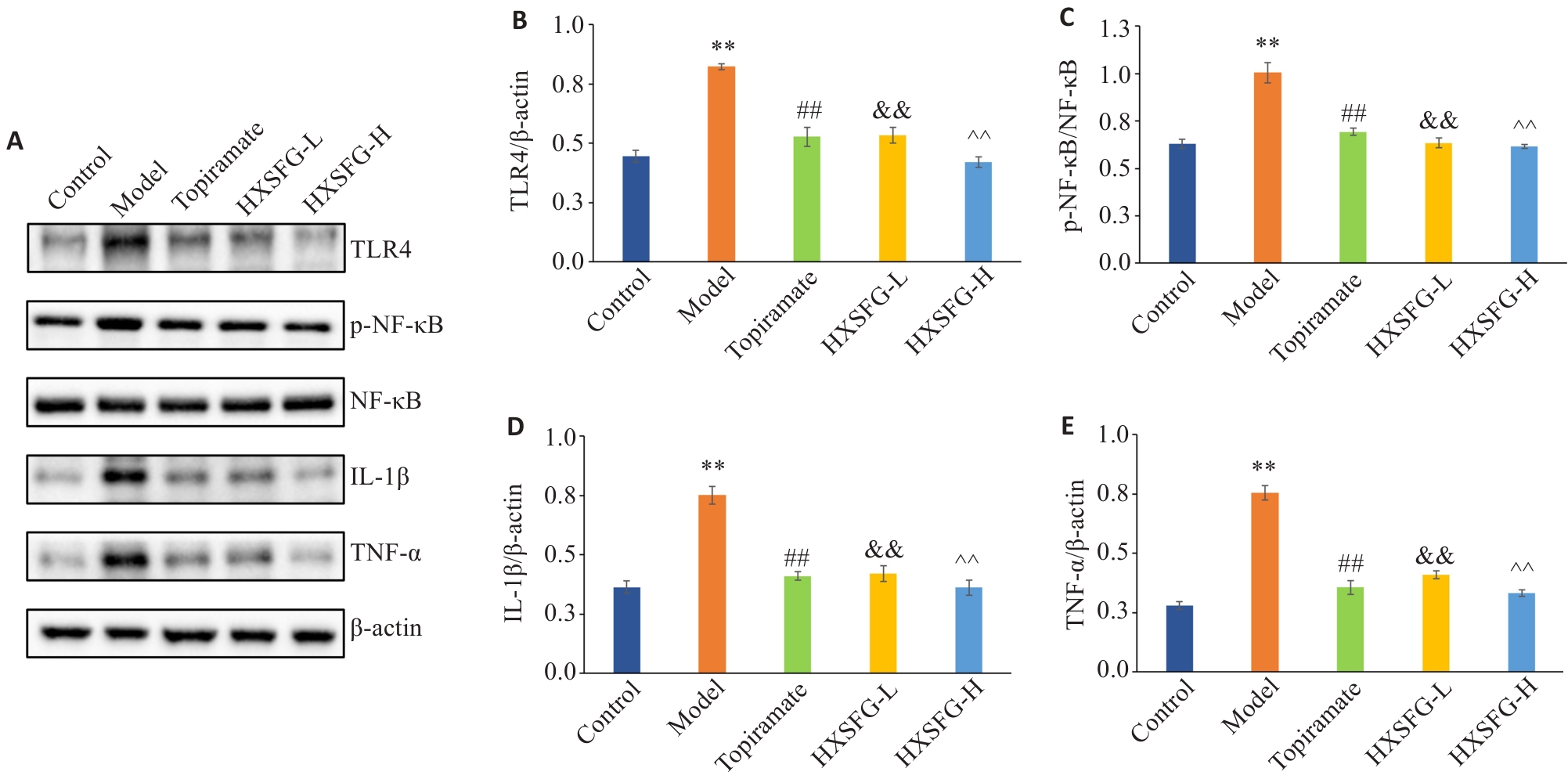
图6 活血疏风颗粒对NTG 诱导的CM小鼠TNC部位TLR4/NF-κB信号通路的影响
Fig. 6 Effects of HXSFG on the TLR4/NF-κB signaling pathway in the TNC region of mice with NTG-induced CM. A: Protein immunoblot images of TLR4, p-NF-κB, NF-κB, IL-1β, TNF-α expression. B: Quantitative analysis of TLR4 protein immunoblotting. C: Quantitative analysis of p-NF-κB/NF-κB protein immunoblotting. D: Quantitative analysis of IL-1β protein immunoblotting. E: Quantitative analysis of TNF-α protein immunoblotting (n=4). Data are presented as Mean±SE. Statistical analysis was performed using two-way ANOVA followed by Tukey's post hoc test. **P<0.01 vs Control group; ##P<0.01 vs Model group; &&P<0.01 vs Model group; ^^P<0.01 vs Model group.
| 1 | GBD 2021 Nervous System Disorders Collaborators. Global, regional, and national burden of disorders affecting the nervous system, 1990-2021: a systematic analysis for the Global Burden of Disease Study 2021[J]. Lancet Neurol, 2024, 23(4): 344-81. |
| 2 | Ashina M, Katsarava Z, Do TP, et al. Migraine: epidemiology and systems of care[J]. Lancet, 2021, 397(10283): 1485-95. |
| 3 | Steiner TJ, Stovner LJ. Global epidemiology of migraine and its implications for public health and health policy[J]. Nat Rev Neurol, 2023, 19(2): 109-17. |
| 4 | Andreou AP, Edvinsson L. Mechanisms of migraine as a chronic evolutive condition[J]. J Headache Pain, 2019, 20(1): 117. |
| 5 | May A, Schulte LH. Chronic migraine: risk factors, mechanisms and treatment[J]. Nat Rev Neurol, 2016, 12(8): 455-64. |
| 6 | Hovaguimian A, Roth J. Management of chronic migraine[J]. BMJ, 2022, 379: e067670. |
| 7 | Boyer N, Dallel R, Artola A, et al. General trigeminospinal central sensitization and impaired descending pain inhibitory controls contribute to migraine progression[J]. Pain, 2014, 155(7): 1196-205. |
| 8 | Volcheck MM, Graham SM, Fleming KC, et al. Central sensitization, chronic pain, and other symptoms: Better understanding, better management[J]. Cleve Clin J Med, 2023, 90(4): 245-54. |
| 9 | Thuraiaiyah J, Erritzøe-Jervild M, Al-Khazali HM, et al. The role of cytokines in migraine: a systematic review[J]. Cephalalgia, 2022, 42(14): 1565-88. |
| 10 | Kursun O, Yemisci M, van den Maagdenberg AMJM, et al. Migraine and neuroinflammation: the inflammasome perspective[J]. J Headache Pain, 2021, 22(1): 55. |
| 11 | Inoue K, Tsuda M. Microglia in neuropathic pain: cellular and molecular mechanisms and therapeutic potential[J]. Nat Rev Neurosci, 2018, 19(3): 138-52. |
| 12 | Liu L, Xu YT, Dai HM, et al. Dynorphin activation of kappa opioid receptor promotes microglial polarization toward M2 phenotype via TLR4/NF-κB pathway[J]. Cell Biosci, 2020, 10(1): 42. |
| 13 | Lu GS, Xiao SB, Meng FC, et al. AMPK activation attenuates central sensitization in a recurrent nitroglycerin-induced chronic migraine mouse model by promoting microglial M2-type polarization[J]. J Headache Pain, 2024, 25(1): 29. |
| 14 | Luo L, Liu M, Fan Y, et al. Intermittent Theta-burst stimulation improves motor function by inhibiting neuronal pyroptosis and regulating microglial polarization via TLR4/NFκB/NLRP3 sig-naling pathway in cerebral ischemic mice[J]. J Neuroinflammation, 2022, 19(1): 141. |
| 15 | Liu Q, Yan R, Wang L, et al. Alpha-asarone alleviates cutaneous hyperalgesia by inhibiting hyperexcitability and neurogenic inflammation via TLR4/NF‑κB/NLRP3 signaling pathway in a female chronic migraine rat model[J]. Neuropharmacology, 2024, 261: 110158. |
| 16 | Erdener ŞE, Kaya Z, Dalkara T. Parenchymal neuroinflammatory signaling and dural neurogenic inflammation in migraine[J]. J Headache Pain, 2021, 22(1): 138. |
| 17 | Chen H, Tang X, Li J, et al. IL-17 crosses the blood-brain barrier to trigger neuroinflammation: a novel mechanism in nitroglycerin-induced chronic migraine[J]. J Headache Pain, 2022, 23(1): 1. |
| 18 | Pijpers JA, Kies DA, van Zwet EW, et al. Cutaneous allodynia as predictor for treatment response in chronic migraine: a cohort study[J]. J Headache Pain, 2023, 24(1): 118. |
| 19 | 龙亚秋, 何文星, 李 华, 等. 陈宝田治疗头痛经验总结[J]. 中国中医基础医学杂志, 2016, 22(2): 213, 226. DOI: 10.3969/j.issn.2095-7246.2016.01.009 |
| 20 | 谢 炜, 洪 雨, 范穗强, 等. 偏头痛分型论治多中心临床观察及疗效分析[J]. 热带医学杂志, 2012, 12(3): 274-8. |
| 21 | 梁雯琳, 谢 炜, 洪 雨, 等. 活血疏风颗粒对偏头痛模型大鼠血浆SP、CGRP和脑干5-HT含量的影响[J]. 时珍国医国药, 2016, 27(12): 2882-4. |
| 22 | Zhang W, Zhang Y, Wang H, et al. Animal models of chronic migraine: from the bench to therapy[J]. Curr Pain Headache Rep, 2024, 28(11): 1123-33. |
| 23 | Al-Hassany L, Goadsby PJ, Danser AHJ, et al. Calcitonin gene-related peptide-targeting drugs for migraine: how pharmacology might inform treatment decisions[J]. Lancet Neurol, 2022, 21(3): 284-94. |
| 24 | Chou TM, Lee ZF, Wang SJ, et al. CGRP-dependent sensitization of PKC‑δ positive neurons in central amygdala mediates chronic migraine[J]. J Headache Pain, 2022, 23(1): 157. |
| 25 | Wu S, Ren X, Ren X, et al. A c-Fos activation map in nitroglycerin/levcromakalim-induced models of migraine[J]. J Headache Pain, 2022, 23(1): 128. |
| 26 | Ho TW, Edvinsson L, Goadsby PJ. CGRP and its receptors provide new insights into migraine pathophysiology[J]. Nat Rev Neurol, 2010, 6(10): 573-82. |
| 27 | Xiao SB, Lu GS, Liu JY, et al. Brain-wide mapping of c-Fos expression in nitroglycerin-induced models of migraine[J]. J Headache Pain, 2024, 25(1): 136. |
| 28 | Ferrari MD, Goadsby PJ, Burstein R, et al. Migraine[J]. Nat Rev Dis Primers, 2022, 8(1): 2. |
| 29 | Chen J, Cai Y, Wei D, et al. Formononetin inhibits neuroinflammation in BV2 microglia induced by glucose and oxygen deprivation reperfusion through TLR4/NF‑κB signaling pathway[J]. Brain Res, 2024, 1845: 149218. |
| 30 | Zhang LL, Wei W. Anti-inflammatory and immunoregulatory effects of paeoniflorin and total glucosides of paeony[J]. Pharmacol Ther, 2020, 207: 107452. |
| 31 | Foudah AI, Devi S, Alqarni MH, et al. Quercetin attenuates nitroglycerin-induced migraine headaches by inhibiting oxidative stress and inflammatory mediators[J]. Nutrients, 2022, 14(22): 4871. |
| [1] | 陈鑫源, 吴成挺, 李瑞迪, 潘雪芹, 张耀丹, 陶俊宇, 林才志. 双术汤通过P53/SLC7A11/GPX4通路诱导胃癌细胞铁死亡[J]. 南方医科大学学报, 2025, 45(7): 1363-1371. |
| [2] | 范正媛, 沈子涵, 李亚, 沈婷婷, 李高峰, 李素云. 补肺益肾方对香烟烟雾提取物诱导的人支气管上皮细胞损伤的保护作用及其机制[J]. 南方医科大学学报, 2025, 45(7): 1372-1379. |
| [3] | 王立明, 陈宏睿, 杜燕, 赵鹏, 王玉洁, 田燕歌, 刘新光, 李建生. 益气滋肾方通过抑制PI3K/Akt/NF-κB通路改善小鼠慢性阻塞性肺疾病的炎症反应[J]. 南方医科大学学报, 2025, 45(7): 1409-1422. |
| [4] | 朱胤福, 李怡燃, 王奕, 黄颖而, 龚昆翔, 郝文波, 孙玲玲. 桂枝茯苓丸活性成分常春藤皂苷元通过抑制JAK2/STAT3通路抑制宫颈癌细胞的生长[J]. 南方医科大学学报, 2025, 45(7): 1423-1433. |
| [5] | 何丽君, 陈晓菲, 闫陈昕, 师林. 扶正化积汤治疗非小细胞肺癌的分子机制:基于网络药理学及体外实验验证[J]. 南方医科大学学报, 2025, 45(6): 1143-1152. |
| [6] | 李国永, 黎仁玲, 刘艺婷, 柯宏霞, 李菁, 王新华. 牛蒡子治疗小鼠病毒性肺炎后肺纤维化的机制:基于代谢组学、网络药理学和实验验证方法[J]. 南方医科大学学报, 2025, 45(6): 1185-1199. |
| [7] | 管丽萍, 颜燕, 卢心怡, 李智峰, 高晖, 曹东, 侯晨曦, 曾靖宇, 李欣怡, 赵洋, 王俊杰, 方会龙. 复方积雪草减轻小鼠日本血吸虫引起的肝纤维化:通过调控TLR4/MyD88通路抑制炎症-纤维化级联反应[J]. 南方医科大学学报, 2025, 45(6): 1307-1316. |
| [8] | 唐培培, 谈勇, 殷燕云, 聂晓伟, 黄菁宇, 左文婷, 李玉玲. 调周滋阴方治疗早发性卵巢功能不全的疗效、安全性及作用机制[J]. 南方医科大学学报, 2025, 45(5): 929-941. |
| [9] | 冉念东, 刘杰, 徐剑, 张永萍, 郭江涛. 黑骨藤正丁醇萃取成分治疗大鼠阿尔茨海默病的药效学及作用机制[J]. 南方医科大学学报, 2025, 45(4): 785-798. |
| [10] | 徐皓男, 张放, 黄钰莹, 姚其盛, 管悦琴, 陈浩. 百蕊草通过调节肠道菌群和调控EGFR/PI3K/Akt信号通路改善小鼠抗生素相关性腹泻[J]. 南方医科大学学报, 2025, 45(2): 285-295. |
| [11] | 高俊杰, 叶开, 吴竞. 槲皮素通过调控TP53基因抑制肾透明细胞癌的增殖和迁移[J]. 南方医科大学学报, 2025, 45(2): 313-321. |
| [12] | 刘莹, 李柏睿, 李永财, 常禄博, 王娇, 杨琳, 颜永刚, 屈凯, 刘继平, 张岗, 沈霞. 加味逍遥丸通过神经递质调节、抗炎抗氧化及肠道菌群调控改善大鼠的抑郁样行为[J]. 南方医科大学学报, 2025, 45(2): 347-358. |
| [13] | 褚乔, 王小娜, 续佳颖, 彭荟林, 赵裕琳, 张静, 陆国玉, 王恺. 白头翁皂苷D通过多靶点和多途径抑制三阴性乳腺癌侵袭转移[J]. 南方医科大学学报, 2025, 45(1): 150-161. |
| [14] | 龙秀鹏, 陶顺, 阳绅, 李素云, 饶利兵, 李莉, 张哲. 槲皮素通过抑制MAPK信号通路改善心力衰竭[J]. 南方医科大学学报, 2025, 45(1): 187-196. |
| [15] | 徐朦, 陈丽娜, 吴金玉, 刘丽丽, 施美, 周灏, 张国梁. “白花蛇舌草-半枝莲”治疗原发性肝癌的机制研究:基于网络药理学、分子对接及体外实验验证[J]. 南方医科大学学报, 2025, 45(1): 80-89. |
| 阅读次数 | ||||||
|
全文 |
|
|||||
|
摘要 |
|
|||||